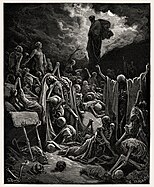
Gustave Doré
Paul Gustave Louis Christophe Doré (UK: /ˈdɔːreɪ/ DOR-ay, US: /dɔːˈreɪ/ dor-AY, French: [ɡystav dɔʁe]; 6 January 1832 – 23 January 1883) was a French printmaker, illustrator, painter, comics artist, caricaturist, and sculptor. He is best known for his prolific output of wood-engravings illustrating classic literature, especially those for the Vulgate Bible and Dante's Divine Comedy. These achieved great international success, and he became renowned for printmaking, although his role was normally as the designer only; at the height of his career some 40 block-cutters were employed to cut his drawings onto the wooden printing blocks, usually also signing the image.[1]
This article is about the French artist. For other uses, see Doré (disambiguation).
Gustave Doré
23 January 1883 (aged 51)
He created over 10,000 illustrations, the most important of which were copied using an electrotype process using cylinder presses, allowing very large print runs to be published simultaneously in many countries.[2]
Death[edit]
Doré never married and, following the death of his father in 1849, he continued to live with his mother, illustrating books until his death of a heart attack in Paris on January 23, 1883, following a short illness.[18] At the time of his death Doré was working on illustrations for an edition of Shakespeare's plays.[19]
Reception and legacy[edit]
Doré's work received mixed reviews from contemporary art critics, but he was widely acclaimed by the general public. He was adored by many writers and poets, who felt he "brought their wildest dreams and fantasies to life".[38] Théophile Gautier for example stated "Nobody better than this artist can give a mysterious and deep vitality to chimeras, dreams, nightmares, intangible shapes bathed in light and shade, weirdly caricatured silhouettes and all the monsters of fantasy."[38] H.P. Lovecraft drew inspiration from Doré's Rime of the Ancient Mariner illustrations in his formative years.


















